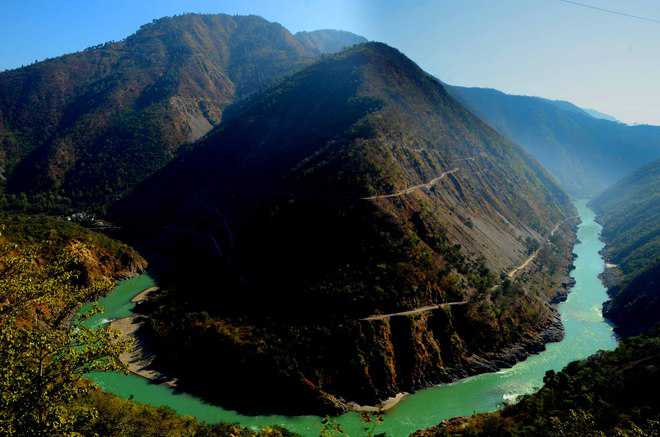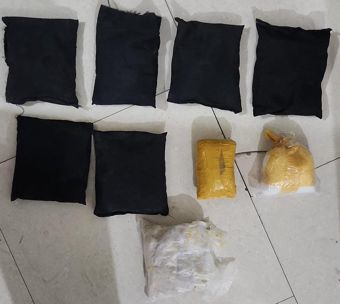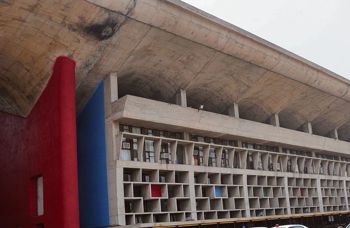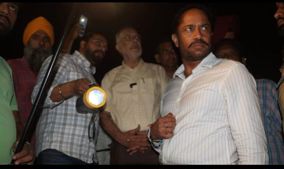
The Mandakini flows brilliantly through high Himalayan valleys of Rudraprayag distirct. Tribune photo: Rameshwar Gaur
Ajay Ramola
Tribune News Service
Mussoorie, April 17
Shyama Devi, a resident of Bicchoo-Takarna village in the Jaunpur development region, has never witnessed a shortage of drinking water like this time. She has to travel more than 5 km to fetch water from the nearest natural spring.
Rajni, a housewife in Mussoorie, is also facing a similar situation as she also has to bring drinking water from the nearest hand pump situated a couple of kilometres from her home.
Rajni’s two school-going children, Jayant and Namit, are now bathing on alternate days. The water is available only for an hour each in the morning and the evening for the past few days. The state boasts of 17 rivers, including the revered Ganga and Yamuna, and several snow-fed glaciers, but the drinking water crisis triggered by less snowfall and rain this year looms large across the Garhwal region.
Natural springs, known as Gadra and Khaal, have dried up while the flow of water at Teen Dhara, a stopover between Rishikesh and Srinagar, has reduced considerably. The situation is likely to worsen with the temperature soaring even in April. Already, villagers in both Ganga and Yamuna valleys are feeling the pinch of water shortage.
For Nainital and Mussoorie, water shortage is a bad news that makes the trading community nervous. At Nainital, the water level in the Naini lake has decreased considerably while at Mussoorie the supply and demand gap is 50 per cent. At present around 7.67 million litre a day (MLD) of water is available while the demand of the town is around 14.50 MLD.
The water is pumped through 14 stations installed at the sources of natural springs around forests to cater to the drinking water need of the town. The demand for water grows manifold with the influx of tourists during the tourist season. With discharge from natural springs falling drastically, groundbreaking and innovative measures such as drawing water from the Yamuna have become imperative.
Several water pumping projects such as at Suridhar and Pratap Nagar in Tehri Garhwal district are pending. In Pauri, people are not getting water from the project though several crores of rupees have been spent.
It is due to the efforts of environmentalists, social activists and the Supreme Court Monitoring Committee that some steps have been taken to augment water supply over the years but these are not enough.
The Supreme Court in its judgement of 1989 in a case filed by eminent social activist Avdhash Kaushal for a ban on mining in the Mussoorie region had expressed concern over felling of trees and degradation of the environment that apparently led to water shortage.
Hugh Gantzer, renowned travel writer and Supreme Court Monitoring Committee member, says the court had said in the judgment, “Unlike the Ganga, which has her main tributaries originating from the mountain ranges and melting snow in the summer helping the tributary to be perennial, the Yamuna used to receive the bulk of her water from the streams joining her in the lower region. The Doon valley used to receive sumptuous rains during the season and tree roots helped the water to be stored and the limestone mines acted as aquifers and the stored water was released in a continuous process. The streams without the support of the melting snow provided perennial supply to the Yamuna..”
Gantzer says the Supreme Court had said, “Due to limestone quarrying, the situation worsened with the felling of trees, resulting in loss of limestone aquifers and depletion of the water level. Blasting affected and shook hill rocks and scree rolled down, damaging cultivable land and adversely affecting villages. The natural beauty of the queen of hills was no more to be seen”. “The Doon Valley stone deposits that were the gift of the nature to the mankind and underneath the soil cover there are unseen storehouses of bounty almost everywhere. Similarly, forests provide the green belt and are bequeath of the past generation to the present. Limestone excavated and utilised get exhausted. Forest exploited can be regenerated provided reforestation is undertaken, but this takes time to grow as ordinarily 15 to 25 years are necessary for such a purpose”.
RBF technique to draw under surface river water
Jotirmay Thapliyal
Tribune News Service
Dehradun, April 17
The Uttarakhand Jal Sansthan is working to provide clean drinking water from below the surface of rivers through the Riverbank Filtration (RBF) technique in the state. The innovative technique is expected to provide a permanent solution to ensure pure drinking water from rivers. The RBF technique is a collaborative effort of the Uttarakhand Jal Sansthan, Indian Institute of Technology, Roorkee, University of Applied Sciences, Dresden, Germany, and Dusseldorf Water Company, Germany.
Senior Jal Sansthan official PC Kimothi says the RBF technique is a credible mechanism to get pure water in a cost-effective manner. The technique has also bagged the National Urban Water Award for 2009 instituted by the Union Ministry of Urban Development.
Instead of using surface water, the RBF technique relies on channelling the water below the surface. The technique has a great potential for Indian towns and cities along rivers but with poor groundwater quality or for those that rely on the direct use of river surface water for drinking purposes.
The riverbank filtration (RBF) or bank filtration is a process of obtaining naturally-filtered ground water from aquifers that are hydraulically connected to a river or a lake. During the RBF, surface water is subjected to a combination of physical, chemical and biological processes such as dilution, filtration and bio-degradation that can significantly improve the quality of water. The presence of bacteria and viruses goes down considerably due to the RBF.



























